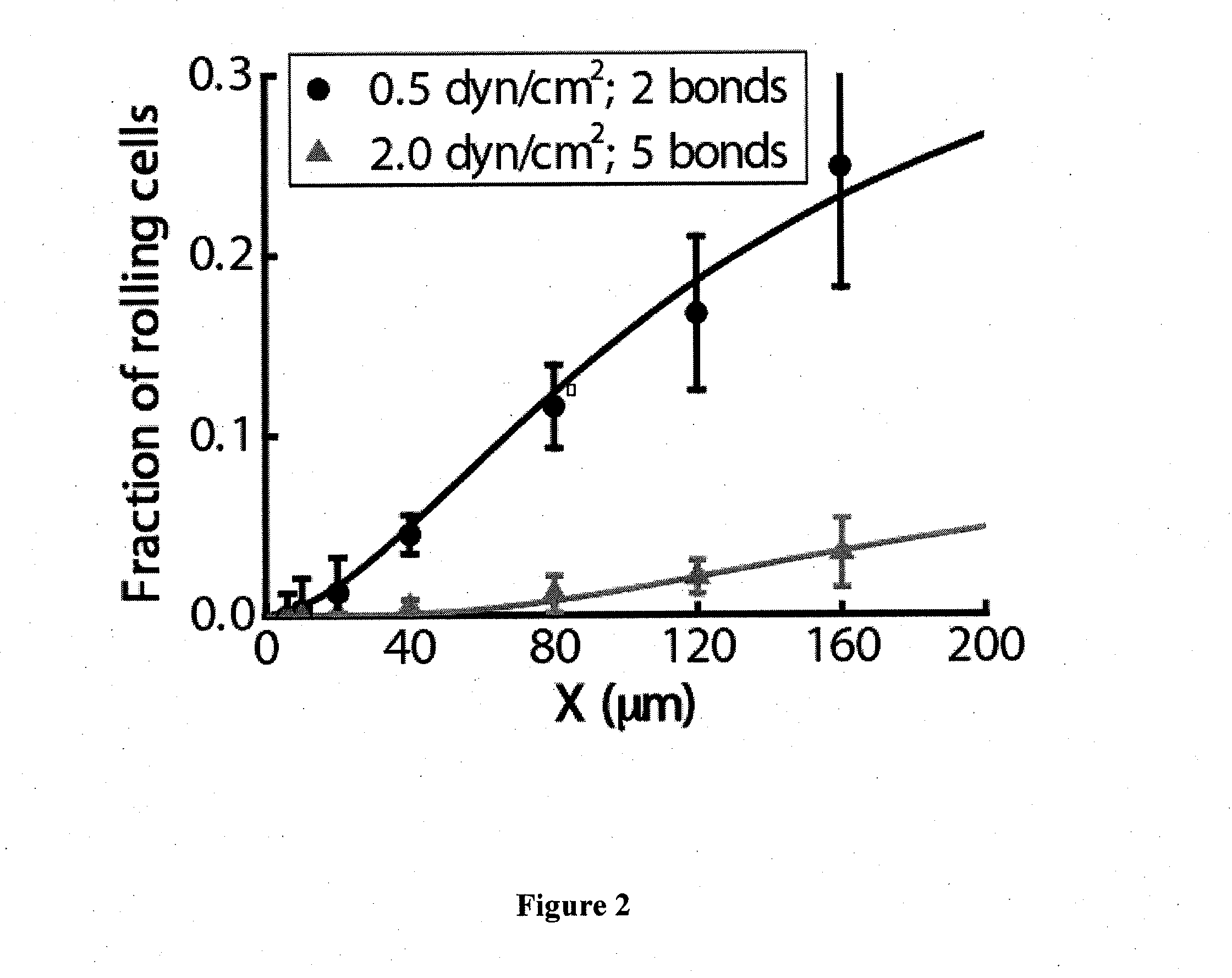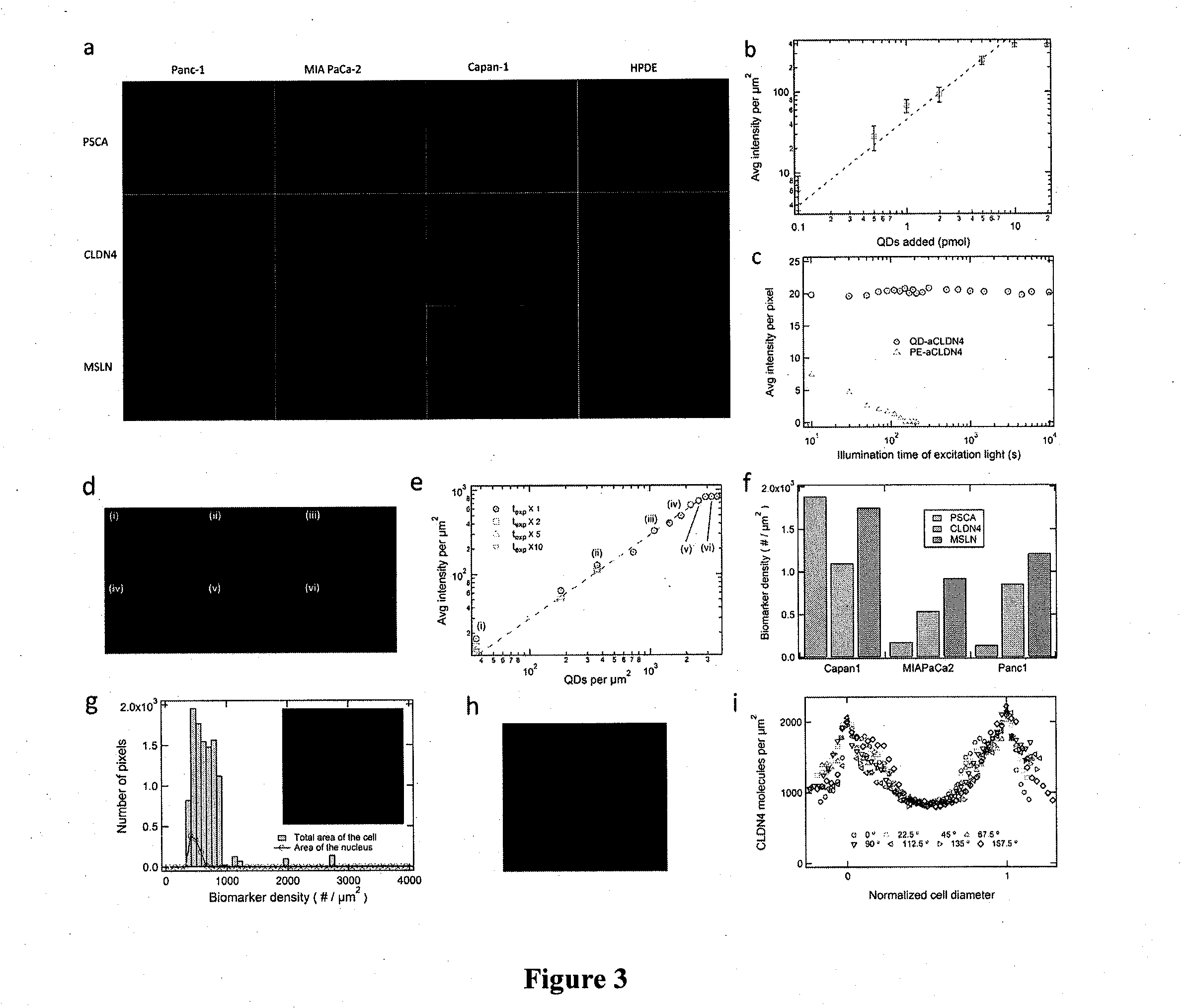Device for capture, enumeration, and profiling of circulating tumor cells
a tumor cell and profiling technology, applied in the field of diagnostic testing for cancer, can solve the problem of requiring several hours of sample processing
- Summary
- Abstract
- Description
- Claims
- Application Information
AI Technical Summary
Benefits of technology
Problems solved by technology
Method used
Image
Examples
example 1
[0056]Development of a microfluidic device for selective capture of free-flowing cells on micro-patterned surfaces. Stripes of fixed width (10 μm) but varying lengths (6, 10, 20, 40, 80, 120 and 160 μm) separated by 100 μm in the direction of flow were patterned on a glass slide using a modified photolithography technique (FIG. 1a) (Ghosh et al. Langmuir 24(15):8134-42, 2008). In brief, a positive photoresist was used to coat a pre-cleaned glass slide surface, which was subsequently exposed to UV light through a chrome mask with the appropriate design. The irradiated regions of photoresist were then dissolved upon incubation with MF-CD-26 Developer. The photoresist-patterned slide was then immersed in 0.1% (v / v) solution of octadecyltrichlorosilane in hexane to render the slide surface hydrophobic. FITC labeled goat anti-human IgG-Fc specific antibody was then added to the slide prior to the immobilization of P- or L-selectin-Ig chimeras at prescribed concentrations (Ghosh et al. La...
example 2
[0060]Quantitative profiling of molecular biomarkers for pancreatic cancer. In preliminary studies we have demonstrated proof-of-principle of quantitative profiling of mesothelin, claudin-4, and PSCA in three pancreatic cancer cells lines. The histologic progression from non-invasive precursor lesions (called Pancreatic Intraepithelial Neoplasia or PanINs) to invasive and metastatic pancreatic cancer is associated with the sequential accumulation of molecular markers (Maitra et al., Adv Anat Pathol 12(2):81-91, 2005; Maitra et al. Mod Pathol 16(9):902-912, 2003; Maitra et al. Annu Rev Pathol 3:157-188, 008; Prasad et al., Cancer Res 65(5):1619-26, 2005). For example, cell surface proteins such as prostate stem cell antigen (PSCA) (Maitra et al. Mod Pathol 16(9):902-912, 2003; Argani et al., Cancer Res 61(11):4320-4324, 2001) are aberrantly overexpressed even at the stage of non-invasive precursor lesions. In contrast, the protein mesothelin is aberrantly overexpressed only on the su...
example 3
[0067]Development of a microfluidic-based device for efficient and selective capture of pancreatic cancer cells: Enumeration of CTCs in peripheral blood of cancer patients has been reported to serve as an indicator of overall survival, disease stage forecasting, and as a promising method for clinical management (Braun et al., N Engl J Med 351(8):824-6, 2004). Nevertheless, detection of CTCs remains challenging due to their extremely low abundance among a high number of circulating blood cells. To this end, most assays employ enrichment steps based on morphometric or immunoseparation methods, which typically provide low recoveries with high purity, or low purity with high recoveries or in other cases, require complex sample processing whose success and reproducibility depend on trained personnel. Microchip technology has recently drawn much attention because of its potential to efficiently and selectively isolate and enumerate CTCs. For instance, a microfluidic approach utilizing an ...
PUM
 Login to View More
Login to View More Abstract
Description
Claims
Application Information
 Login to View More
Login to View More - R&D
- Intellectual Property
- Life Sciences
- Materials
- Tech Scout
- Unparalleled Data Quality
- Higher Quality Content
- 60% Fewer Hallucinations
Browse by: Latest US Patents, China's latest patents, Technical Efficacy Thesaurus, Application Domain, Technology Topic, Popular Technical Reports.
© 2025 PatSnap. All rights reserved.Legal|Privacy policy|Modern Slavery Act Transparency Statement|Sitemap|About US| Contact US: help@patsnap.com



